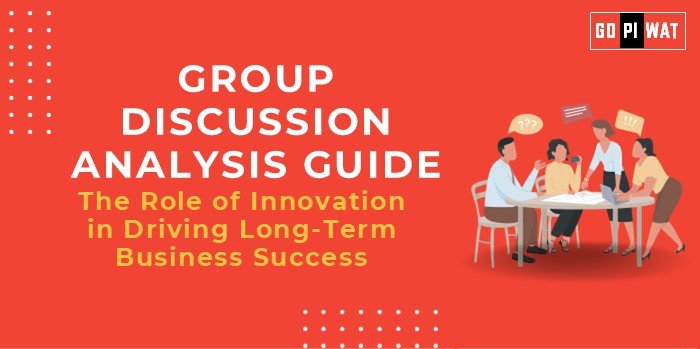📋 Group Discussion Analysis Guide
🌐 Topic: The Role of Innovation in Driving Long-Term Business Success
💡 Introduction to the Role of Innovation
- Opening Context: Innovation is the cornerstone of sustainable business growth, driving competitiveness and value creation in an ever-evolving global economy. In an era defined by rapid technological changes, businesses that embrace innovation outperform competitors and thrive long-term.
- Topic Background: Historically, businesses like Apple, Google, and Amazon have demonstrated that consistent innovation—be it product-based, operational, or strategic—is crucial for longevity. The global pandemic reinforced the importance of innovation as companies pivoted to survive and adapt.
📊 Quick Facts and Key Statistics
- 🌍 Global R&D Investment: Over $2.5 trillion invested in R&D annually worldwide (UNESCO, 2023), reflecting the critical role of innovation in driving economic growth.
- 🏆 Top Innovators: Companies like Apple, Tesla, and Microsoft are leaders due to their continual product innovation and market disruption.
- 📈 SMEs and Innovation: About 60% of SMEs report increased revenue growth after implementing innovative solutions (OECD, 2023).
- 📉 Failure to Innovate: 52% of Fortune 500 companies have disappeared since 2000 due to lack of adaptability and innovation.
- 💰 Economic Impact: Nations leading in innovation (e.g., USA, Germany, Japan) account for 60%+ of global GDP.
👥 Stakeholders and Their Roles
- Corporate Leaders: Drive strategic initiatives and allocate resources to R&D and innovation.
- Employees: Foster a culture of creativity, contribute ideas, and implement innovative practices.
- Investors: Support businesses prioritizing long-term innovation for sustainable returns.
- Governments: Facilitate innovation ecosystems through policies, tax benefits, and R&D grants.
- Consumers: Influence businesses through evolving demands and preferences for innovative solutions.
✅ Achievements and Challenges
Achievements:
- ⚙️ Technological Advancements: Breakthroughs in AI, blockchain, and IoT have redefined industry processes.
- 🚗 Business Disruption: Companies like Tesla disrupted automotive norms with electric vehicles.
- 📊 Revenue Growth: Innovative businesses report 20-40% higher revenue growth than non-innovators (Deloitte, 2023).
- 🔄 Resilience and Adaptation: Firms like Zoom and Netflix thrived by innovating amid challenges.
Challenges:
- 💸 Risk and Uncertainty: High R&D costs with uncertain ROI deter businesses from investing.
- 📋 Organizational Resistance: Legacy systems and cultural inertia hinder innovation adoption.
- 🌐 Global Comparisons: Countries like China dominate with state-supported innovation hubs, while smaller economies lag behind.
Case Study: Amazon: From a book retailer to a global tech conglomerate through continuous innovation in e-commerce, logistics, and cloud computing (AWS).
📚 Structured Arguments for Discussion
- Supporting Stance: “Innovation is the lifeblood of businesses, ensuring competitive edge, market leadership, and sustainable profitability in dynamic industries.”
- Opposing Stance: “Excessive focus on innovation can lead to resource wastage, high risk, and market misalignment, especially for smaller companies.”
- Balanced Perspective: “While innovation is vital for business success, strategic balance, risk management, and resource optimization are equally crucial for long-term growth.”
💬 Effective Discussion Approaches
- Opening Approaches:
- 📊 “Companies like Tesla and Apple have proven that innovation ensures survival and market leadership in an age of disruption.”
- 📉 “Over 52% of Fortune 500 companies failed due to their inability to innovate and adapt to market changes.”
- Counter-Argument Handling:
- “While innovation is costly, companies like Microsoft show that strategic R&D investment results in exponential returns and market resilience.”
🧐 Strategic Analysis of Strengths and Weaknesses
- Strengths: Competitive edge, revenue growth, market leadership, resilience.
- Weaknesses: High R&D costs, organizational resistance, uncertainty of outcomes.
- Opportunities: Emerging technologies (AI, IoT), open innovation, global markets.
- Threats: Technological obsolescence, market competition, economic downturns.
📖 Connecting with B-School Applications
- Real-World Applications: Innovation in supply chain operations (e.g., Walmart), financial strategies (Fintech), and corporate development (mergers and acquisitions).
- Sample Interview Questions:
- “How can businesses balance innovation with cost management?”
- “Discuss a case study where innovation transformed an industry.”
- Insights for B-School Students: Analyze innovation frameworks like Blue Ocean Strategy and Disruptive Innovation. Focus on technology-driven projects, startups, and global innovation benchmarks.


